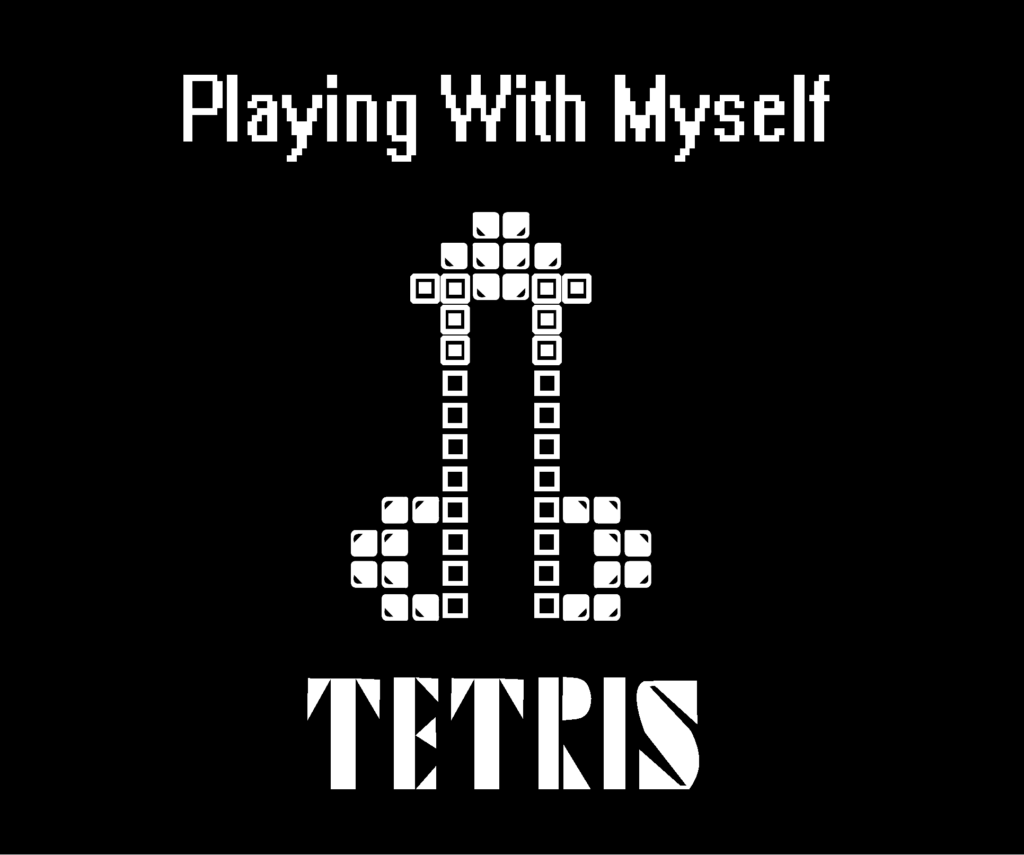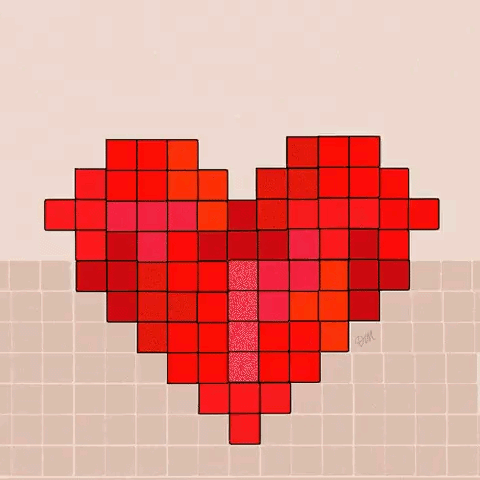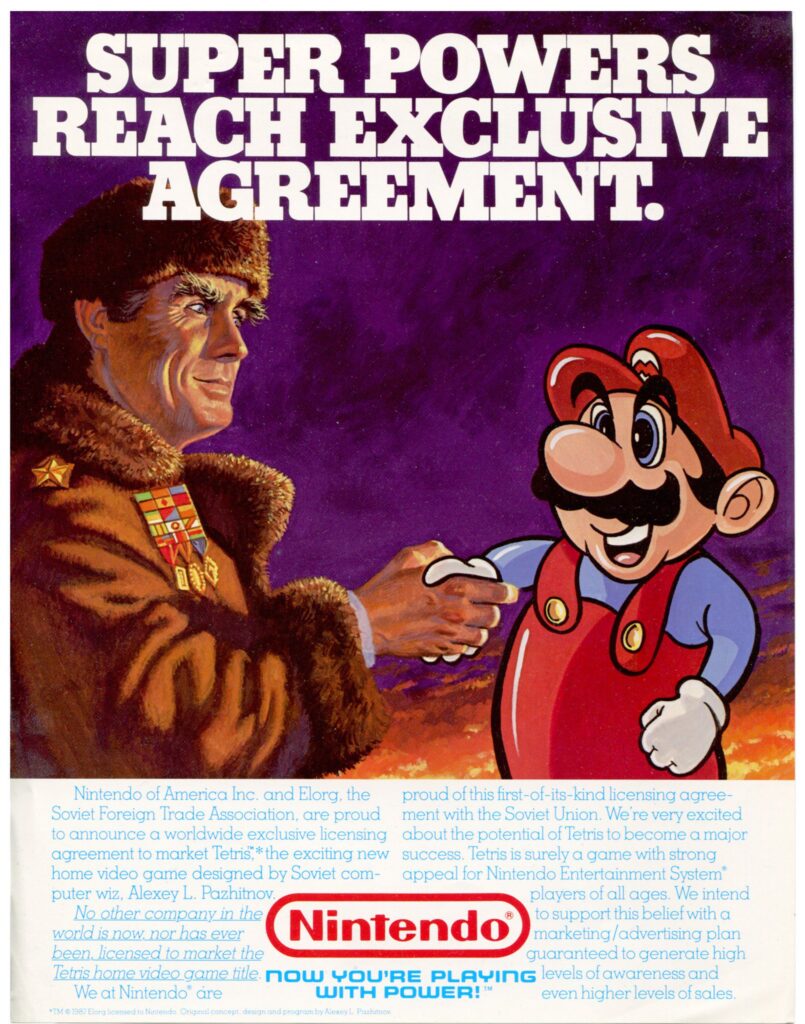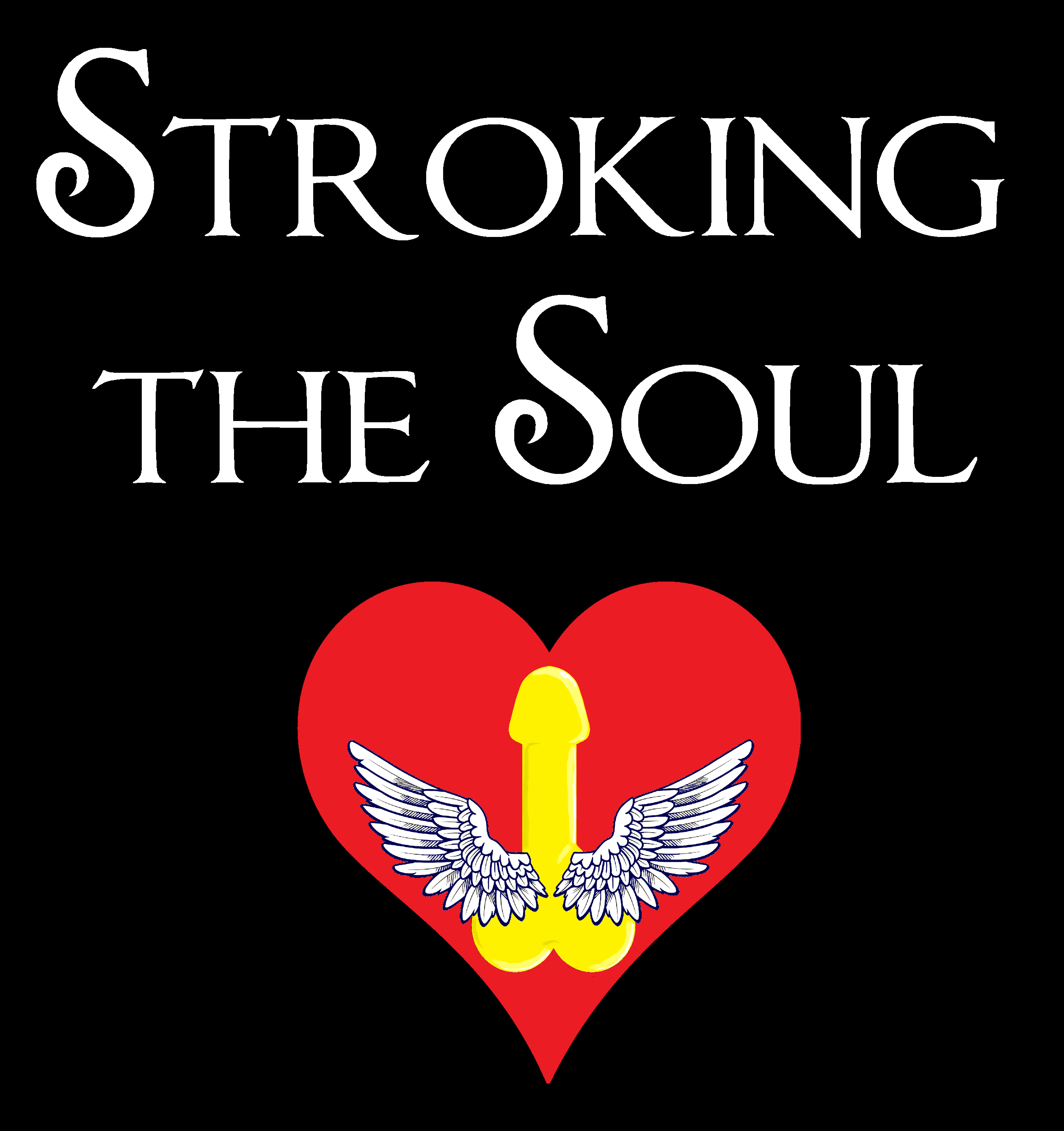
Playing with Myself: Tetris

Welcome to the first entry in the “Playing With Myself” series, in which I review single-player games and toys that I enjoy. (I also can’t resist a masturbation pun.)
I’ve been interested in writing game reviews for a while, and I thought it would be fun to do something a little different from my usual content.
My interest in gaming is primarily nostalgic, so most of my favorite games are from my childhood, but I do also enjoy some modern games.
I also find that playing games provides a nice respite from researching and writing. It gives my brain a break from work while still keeping me intellectually engaged.
Today is World Tetris Day (June 6), so what better game to kick off the series than Tetris?
In Soviet Russia,
puzzle game plays you!
☭
Tetris (Тетрис) was conceived near the end of the Cold War era, and it swiftly spread to arcades, personal computers, and gaming consoles throughout the 1980s and 90s.
Its popularity has never diminished, and new editions of Tetris continue to be produced today. There are even legitimate Tetris tournaments, such as the Classic Tetris World Championship.
My Favorite Versions
There have probably been hundreds of licensed and unlicensed versions of Tetris produced over the past four decades. I would go mad if I tried to play them all, but I have played a few.
You will notice that this list is primarily Nintendo versions, and that’s because I think those are usually the best, and for good reasons.
I have also played several PC versions, including the 1986 IBM PC version, which was the first version to cross the Iron Curtain into Europe. The controls of those early PC games use the number pad on the keyboard, which takes some getting used to. Modern PC games use arrow keys instead.
But the best way to play Tetris is not with a computer keyboard.
The simplicity of a controller or handheld with a D-pad, start and select buttons, and A and B buttons, is the way to go.
Here are some of my favorites:
Tetris
Game Boy (1989)
Tetris was released as a launch title packaged with the Nintendo Game Boy in 1989, and it was a smashing success.
It was the ideal game to include with the new handheld console because the graphics and mechanics of the game are simple, and it’s a challenging puzzle game with universal appeal for all genders and ages.
Tetris has evolved a bit over the years, but if you’re like me and prefer the basics, this is it. It’s regular Tetris, plain and simple, without any frills.
Absent are certain game mechanics like hard drops and ghost pieces, which became standard in later versions. Truth be told, classic Tetris doesn’t need these features. It’s timeless for a reason!
The Game Boy version is perfect for anyone who enjoys having a portable form of Tetris, which I believe is the ideal way to play it.
For many, it remains the definitive version. It elevated Tetris from a minor Russian computer game to a global household name.
Tetris
NES (1989)
There were two versions of Tetris produced for the NES in North America. The first was created by Tengen, a subsidiary of Atari, who was Nintendo’s archrival. In my opinion, this version is inferior.
The main highlight of Tengen’s version (aside from the animations of Russian folk dancers) is the option for two-player mode. It is, in fact, a port of Atari’s arcade version, so it was designed to be a versus game.
But even in single-player mode, the screen is always divided into two playing fields, which is a needless distraction and waste of space. This is just one of the problems I have with this version.
I highly recommend Nintendo’s official version instead, which is single-player only and much more visually appealing. It outshines Tengen’s version in almost every way.
The color palette changes as the levels advance, which means the pieces are not limited to the same set of colors like in other versions.
The background is simple and plain, which makes it a bit easier to focus on gameplay, instead of being distracted by Russian imagery or animated backgrounds.
Just like the Game Boy version, it’s straight-up Tetris without any bells and whistles.
The official NES version is also the official version used by the Classic Tetris World Championship, which I think says a lot.
Tetris 2
NES (1993), SNES (1994)
Many Tetris fans scoff at this title and claim that it’s “not really Tetris,” but I argue that it has much more in common with traditional Tetris than some of the other official sequels, like Hatris and Faces…tris III.
Tetris 2 plays like a combination of Tetris and Dr. Mario. It involves color-matching and uses irregular pieces that deviate from the standard tetrominoes, including one that looks like a cock and balls.

It’s a fun variation on the game, and it feels a bit more casual than a standard Tetris game.
The basic gameplay of both the NES and SNES versions is the same. The main difference is that the SNES version includes animated backgrounds and weird cut scenes with boring characters.
There was also a version for the Game Boy, but I think a color-matching game on a black-and-white screen is not nearly as effective. The same is true for Dr. Mario.
Tetris Blast
Game Boy (1996)
In the early 90s, several Tetris variants incorporated pieces that contain bombs, which significantly changed the gameplay. In Japan, these games were called Bombliss.
I’ve tried every version of this game, and I feel that most of them are both lacking in excitement and frustratingly difficult. But Super Bombliss is when they perfected the formula.
In North America, Super Bombliss was released as Tetris Blast.
The objective of the game is to line up the bombs in particular ways, so when you clear out rows, the bombs detonate and set off a chain reaction that blows up all the blocks on the screen.
If you put four bombs together in a square, it creates a big bomb that can help to clear out the board.
The only downside to this version is that it uses a password system instead of save files, which means that if you don’t write down any of your passwords, you have to start at the beginning every time you play.
But I don’t mind that much because the game is always fun. It’s playing with blocks and blowing stuff up. What’s not to love?
Tetris Plus
Game Boy (1996)
The main feature of Tetris Plus is the Puzzle Mode. Each stage starts off with a prearranged layout of blocks on screen. A tiny archaeologist known as the Professor walks on top of them as a spiky ceiling slowly descends.
The objective is to clear the blocks to expose the bottom of the playing field so the Professor can safely reach the ground before the spiky ceiling crushes him.
Once he reaches the goal, he exits through a door and enters the next stage, which features a different and more challenging configuration of prearranged blocks.
When you drop blocks on the Professor, he will climb on top of them, even if he climbs right into the spikes. It seems that our Professor is not very bright in this regard, which is probably why the player is tasked with saving him from these perils.
It’s a fun twist on the traditional Tetris… even if that spiky ceiling is anxiety-inducing when it comes dangerously close.
Tetris DX
Game Boy Color (1998)
Tetris DX is the original Tetris updated for the Game Boy Color.
It looks almost identical to the original Game Boy version, but in beautiful, bright, luscious colors. Just like the NES version, the colors change from level to level. It also features two new game modes.
As far as overall gameplay, the original and DX are pretty much equal. But if I had to choose between the two, I definitely prefer Tetris in full color, as it is meant to be.
Tetris in the 2000s
My interest in video games began to wane in the early 2000s. I lost interest in following the constantly changing generations of game consoles, and I felt that the gaming industry was going in a different direction from what I used to enjoy.
I still played games on occasion with my brothers and friends, but by that point, I was much more focused on my creative endeavors, especially music and writing.
So I didn’t play any modern Tetris variants until recently. The versions I’ve played include Tetris Worlds (2001), Tetris Advance (2003), Tetris Elements (2004), and Puyo Puyo Tetris 2 (2021).
In the first draft of this article, I included a review of Tetris Elements. The main points were that I enjoyed how the elements of nature were incorporated into the gameplay, but the controls were clunky and frustrating (especially the hard drop).
I also commented on how the gameplay is much more fast-paced than traditional Tetris, which seems to be true of many modern Tetris games.
The Tetris of my youth was a more casual single-player game, but speed running is common among modern gamers, especially those in competitive, multiplayer circles.
The Tetris games of the early 2000s experimented with different types of gameplay, but I feel that none of them got it quite right. In my opinion, all those other games were just paving the way for the best modern Tetris game.
Tetris Effect: Connected
Steam/Windows (2021)
Tetris Effect: Connected is more than a game, it is a multisensory masterpiece. I come from the old school of Tetris, but this one might make me a convert.
It is, by far, the greatest modern version of Tetris. It simply blows the competition out of the water.
It was on my wish list for a long time, and I finally bought it this spring. I waited until Steam had a sale because the full price is $40. As amazing as this game is, it’s not worth that much to me.
I ended up getting it at half price. Score!
Before I get into the game itself, I want to tell you how ecstatic I was to discover that this game has controller support. Most of the games I play on Steam use the keyboard and/or mouse. With Tetris Effect: Connected, you get to choose.
I had no prior experience with USB game controllers, so I did some research. I settled on the 8BitDo SN30 Pro. SN stands for Super Nintendo, as it is modeled after the original SNES game controller.
There was a wireless version, but I bought the one with the long cord that’s always in the way because I wanted the full nostalgia gaming experience. It has all the buttons I need for pretty much any game, and it feels nice in my hand. For a retro gamer like me, this controller is perfect.
Tetris Effect: Connected is a psychedelic orgasm of sight, sound, and sensations. There are 27 different stages (and a couple of secret ones), each with its own theme, including block skins, background graphics, music, and sound effects.
It is an interactive experience in which every button you press influences what happens in the stage. First, you may hear an instrument, voice, or sound effect. As you continue to play, these sounds turn into melodies and songs.
The soundtrack is very eclectic. Some of the songs are upbeat and others are more chill. I recommend using headphones or playing through high quality speakers to really soak in the music. It’s a crucial part of the gameplay.
My controller also has a rumble feature that vibrates to the beat of the song, which adds so much to the experience.
The visuals are absolutely stunning and work in tandem with the music. Characters in the background may react to your gameplay. As you continue to clear lines, the stage will evolve and the background will transition to a new scene.
The song will also pick up tempo or change to a different movement, and this can also suddenly change the speed at which the pieces fall.
A unique and important feature of the game is the Zone mechanic. As you clear lines, your Zone meter will fill up. When it reaches max, you can activate it. When in the Zone, everything slows down for a limited time. This allows you to make combos that would normally be impossible to achieve.
In a standard game of Tetris, the most lines you can clear at once is four; a four-line clear is called a “Tetris.” In Zone mode, however, it is possible to create combos that add up to larger numbers.
Zone clear names:
Tetris: 4-7
Octoris: 8-11
Dodecatris: 12-15
Decahexatris: 16-17
Perfectris: 18-19
Ultimatris: 20
Kirbtris: 21
Impossibilitris: 22
Infinitris: 23
Electris: 24
WTFtris: 25+
I don’t have a VR headset, but this game is VR-supported. The game is already trippy and mesmerizing without it, so I imagine that the virtual reality experience would be the ultimate mindgasm.
Journey Mode is the primary single-player mode. You play through the stages one after another until you reach the final stage, Metamorphosis.
Some notable stages:
Dolphin Surf
Dolphin noises and aquatic sounds. At one point, the dolphins jump out of the water in response to your playing. It’s fun, relaxing, and much less frustrating than Ecco the Dolphin.
Downtown Jazz
The stage starts with jazz chords on piano and honking traffic, as the scene depicts city streets with buildings, neon signs, and lots of moving lights.
Kaleidoscope
It is just what it sounds like—a trippy, ever-shifting kaleidoscope!
Zen Blossoms
Water lilies and tranquil music. Very peaceful and meditative.
Hula Soul
Hawaiian volcanoes and Polynesian-inspired rhythms. The one is notable because the sudden shift in tempo makes it very difficult. I’m more likely to lose on this stage than any other. Once those drums start to pick up, I know I’m screwed.
There is also the Theater Option, which allows you to “play” through the stages without the Tetris game. You still push buttons and interact with the stage as it progresses, but there are no falling pieces. It’s a much more casual, laid-back experience.
If you get tired of playing through Journey Mode, the Effects Modes menu contains 17 other gameplay modes to choose from. Some are very challenging and others are very relaxing, so there are plenty of options.
This review is mainly for single-player games, but there is also a Multiplayer menu with different types of matches you can play with people locally and all over the world.
This was a new experience for me, and I was pleased to discover that the Tetris Effect: Connected online community is usually quite active. I can sign on at just about any time and there are at least a few players online. Sometimes I have to wait a while, but the wait times are usually not excessive.
There are also weekend events held regularly, which draw a lot more players.
The multiplayer experience is very different from the single-player experience, although they share most of the same elements: music, zone mechanic, etc.
I could go on and on about this game, but it really is incredible. If you want a game that stimulates your senses with great music, cool visuals, and lots of variety, you can’t go wrong with this. It is available on Steam and many other platforms.
History of the Game
The original Tetris was created by software engineer Alexey Pajitnov in 1984, at the Soviet Academy of Sciences in Moscow. He was inspired by the puzzle games he played as a child and wanted to translate that experience into a computer game.
Working within the limitations of the outdated computers available at the Academy, he created a game using tetrominoes, which are blocks consisting of four squares arranged into five basic shapes. He called his creation “Tetris,” derived from the Greek word tetra, meaning “four,” and tennis, his favorite sport.
Tetris spread like wildfire, first within the Academy, and then all throughout the Soviet Union. It wasn’t long before the game entered Europe via Hungary, which is when it caught the attention of businessmen seeking to cash in on it.
Due to shady business practices and a complicated mess of licensing and sublicensing, a long list of different companies claimed to have publication and distribution rights to the game.
However, because the game was created at the Academy, it was property of the state. All negotiations for the rights to Tetris were handled by Elektronorgtechnica (“ELORG”), an organization responsible for importing and exporting electronics in the USSR.
Three men flew to Moscow in the same week to meet with ELORG and vie for the rights to Tetris. The first was Robert Stein of Andromeda Software, who was responsible for creating the whole mess. Another was Kevin Maxwell, son of publishing tycoon, Robert Maxwell.
But the most important of these men was Henk Rogers of Bullet-Proof Software (now known as Blue Planet Software), who was an official licensee for Nintendo at the time.
Unlike the other men, Rogers earned the trust of ELORG and made a clear and honest deal to secure the handheld and home console rights for Nintendo.

The only person who didn’t cash in on the game was its creator, Alexey Pajitnov, who continued to work for the Academy. For over a decade, he never saw a penny for his creation. But his patience would pay off in the long run.
Alexey Pajitnov and Henk Rogers became good friends from the very first time they met during the ELORG negotiations.
Pajitnov was immediately impressed with the Dutch-American because he was also a game developer and actually understood the game, instead of just being another businessman in a suit whose only concern is money.
Rogers bonded with the Russian because he was looking for a friend in Moscow from the day he arrived, and now he had a comrade to talk to about common interests.
Rogers helped Pajitnov and his family immigrate to the United States in 1991. When the rights to Tetris expired, the two friends formed The Tetris Company in 1996 and purchased 50% of the rights to the game; the other half belonged to ELORG.
In 2005, ELORG sold its share to The Tetris Company. Over two decades after he first created it, Alexey Pajitnov was finally earning a comfortable living from his game.
The true lesson in the story of Tetris is how friendship prevailed over both communism and corporate greed.


There are a couple of documentaries and a movie about the history of Tetris.
The 2004 BBC documentary, Tetris: From Russia with Love, features interviews with many of the people behind the game, including Pajitnov, Rogers, Nicolai Belikov of ELORG, Howard Lincoln of Nintendo of America, Randy Broweleit of Atari Tengen, Robert Stein of Andromeda Software, and more.
Gaming Historian on YouTube made a documentary called The Story of Tetris, in which he goes deep into the tangled web of legal rights behind the game, and the international conflict between these different men who all played a part in its creation and distribution.
On March 31, 2023, a semi-biographical film called Tetris was released on Apple TV+. The biopic tells the story behind the game, but with big Hollywood flourishes and exaggerations.
Alexey Pajitnov and Henk Rogers reviewed the script and made suggestions, but ultimately the filmmakers were more interested in making a thrilling, action-packed film. I don’t have Apple TV+ so I haven’t seen it, but the trailer looks exactly like you’d expect.
So, if you want suspense, drama, and high-speed car chases that never actually happened, this film fulfills those Hollywood cliches. But if you want something more historically accurate, I suggest watching the documentaries by the BBC and Gaming Historian instead.
